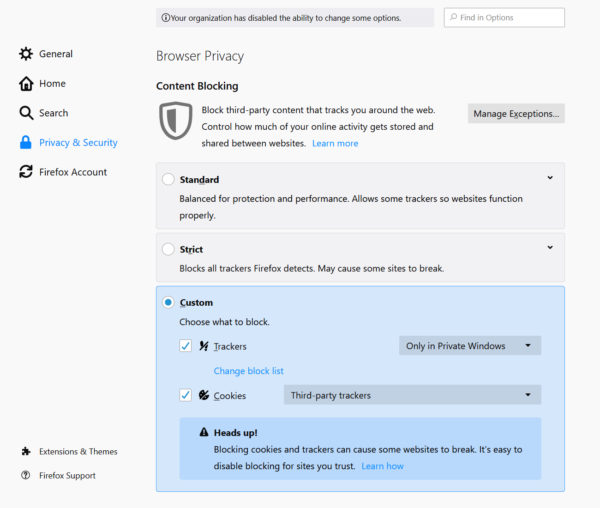What if I told you that on nearly every single website you visit, data about you was transmitted to dozens or even hundreds of companies, all so that the website could earn an additional $0.00008 per ad! This is a key finding from a new study on behaviorally targeted advertisements from Carnegie Mellon University and it should be a wake-up call to all of us. The status quo of pervasive data collection in service of ad targeting is untenable. That is why we’re announcing some key changes to Firefox.
Today marks an important milestone in the history of Firefox and the web. As of today, for new users who download and install Firefox for the first time, Enhanced Tracking Protection will automatically be set on by default, protecting our users from the pervasive tracking and collection of personal data by ad networks and tech companies.
It seems that each week a new tech company decides to decree that privacy is a human right. They tout how their products provide people with “choices” to change the settings if they wish to opt into a greater level of privacy protection to exemplify how they are putting privacy first. That begs the question — do people really want more complex settings to understand and fiddle with or do they simply want products that respect their privacy and align with their expectations to begin with?
Privacy shouldn’t be relegated to optional settings
When thinking about consumer privacy online, I’m reminded of the behavioral economics studies which led to 401K plans (US retirement savings plans) moving from voluntary enrollment to auto-enrollment. Not too long ago most defined contribution retirement savings plans in the US required employees to sign-up and volunteer to start participating. Participation rates were very low. Why was that? Was it because people didn’t care about saving for retirement? Not at all! There were simply too many barriers to aligning with people’s expectations and desires and the benefits of saving for retirement aren’t felt immediately.
We are in a similar position with respect to software privacy settings. Pervasive tracking is too opaque and potential privacy harms are never felt immediately. The general argument from tech companies is that consumers can always decide to dive into their browser settings and modify the defaults. The reality is that most people will never do that. Yet, we know that people are broadly opposed to the status quo of pervasive cross-site tracking and data collection, particularly when they learn the details on how tracking actually works.
We also know that traditional privacy features such as Chrome’s Incognito mode are failing to live up to consumer expectations. The feature might keep your spouse from knowing what you’re thinking about getting them for your anniversary by erasing your history, but it does not prevent third-party tracking. Our research shows that Firefox users are seeking out privacy protection, particularly through the use of Firefox’s Private Browsing mode. In fact, nearly 25% of web page loads in Firefox take place in a Private Browsing window. The good news for these users is that Firefox’s Private Browsing mode has long put users first by blocking tracking. The bad news is that this generally isn’t true for many popular browsers, which allow tracking even in private browsing/incognito mode. A recent study found that users don’t understand this and think their data is being protected, when it is actually not.
As was the case with retirement savings plans, what this shows us is that the burden needs to shift from the consumers to the companies whereby the complexity of privacy settings shouldn’t be placed on users to figure out. The product defaults should simply align with consumer expectations. That is the approach we are taking in Firefox.
Enhanced Tracking Protection by Default
As stated above, new Firefox users will have strong privacy protection from the moment they install. We also expect to deliver the same functionality to existing users over the coming months. Because we are modifying the fundamental way in which cookies and browser storage operate, we’ve been very rigorous in our testing and roll-out plans to ensure our users are not experiencing unforeseen usability issues. If you’re already using Firefox and can’t wait, you can turn this feature on by clicking on the menu icon marked by three horizontal lines at the top right of your browser, then Content Blocking. Go to your privacy preferences and click on the Custom option on the right side. Mark the Cookies checkbox and make sure that “Third-party trackers” is selected. To learn more about our privacy and security settings and get more detail on what each section — Standard, Strict, and Custom — includes, visit here.

If you are new to Firefox, we’d love for you to give it a try. Download the latest version here.
When it comes to privacy, default settings matter! We hope that the actions we are taking can ultimately compel change in the industry. Afterall, consumers deserve better.



